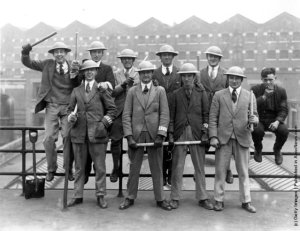1926 General Strike at 90: some outstanding issues - cross posted from Keith Flett's blog
The 1926 General Strike took place from 4-13th May 1926. The miners lock-out which it was meant to be the central act of went on for much longer until the end of November 1926.
The British Worker, the TUC paper during the dispute did not stop publishing until May 17th 1926
It was not the only General Strike in UK history by any means. There was one in 1842 sometimes called condescendingly the ‘plug plot’ and from the 1970s onwards there have been a number of, in effect, one day national strikes on a range of issues. Given the size of the modern workforce numbers involved in these have often been equal to or larger than those who took action in 1926.
It might be questioned whether after 90 years there is much new to say about the General Strike and the general parameters of events over the 9 days are well known enough.
However the detail of what took place during the strike covers a vast range of written and photographic material some of which has only in very recent times being made accessible digitally on the internet.
For example, the MCC issued a call for cricket matches to continue as normal during the strike but one at Lords between Middlesex and Oxford University was cancelled. No doubt the Oxford students were engaged in the, to them, alternative sport of strike breaking.
Local studies have provided more details (but far from all areas are covered) and the miners lock-out remains relatively under researched as does the aftermath of the strike and the impact that it had on unions, politics and labour relations for decades to come.
Arthur Scargill for example became active in the labour movement when memories of 1926 were still relatively fresh in the 1950s and saw the victorious 1972 miner’s strike in the context of the defeat of 1926.
The wider and partly theoretical question about why there has not been an open ended General Strike in Britain since, when such events are far from unknown across the rest of the world, is also one which merits further attention.
When one looks at the detail of the strike it is possible to see many of the tensions that still exist in the labour movement today.
For example the strike meant that newspapers were not published and the only news available was through radio news broadcasts from the BBC. Then as now these reflected official Government views.
The only exception to this, no surprise to Star readers, was the Daily Mail which published a ‘continental’ edition, printed in Paris.
The Government itself produced an official paper and this was countered by the TUC’s British Worker.
The British Worker was produced from the Daily Herald’s offices in Blackfriars Rd and edited by the Herald’s then editor.
It was still published for some days after the official end of the strike on 13th May and by that stage it had reached an impressive circulation of 700,000 copies.
However distribution across the UK was uneven and poor in Scotland.
Plans were put in place to produce regional editions of the British Worker for two reasons. Firstly to address the matter of coverage. Secondly to allow local reports of strike activities which might otherwise be missed.
The nine days of the Strike were a time of considerable, often ill-founded rumours, often spread by authorities and reactionary elements.
The concern however was that regional strike papers might go beyond the official TUC ‘line’. In addition in some areas, such as Swansea, striking print workers were against the idea.
The strike was called off before these matters of official control, solidarity and so on could be resolved but the same issues would undoubtedly appear again now.
Keith Flett
Keith Flett
The London Socialist Historians Group has organised an afternoon of discussion on new historical research into the 1926 General Strike on Saturday 21st May from midday in the Pollard Room (301) Institute of Historical Research, Senate House, Malet St, London, WC1. Admission is free for more details see here
Edited to add: Ian Birchall's paper from the conference - how 1926 was seen by the French Left - is now online here
Edited to add: Ian Birchall's paper from the conference - how 1926 was seen by the French Left - is now online here


No comments:
Post a Comment